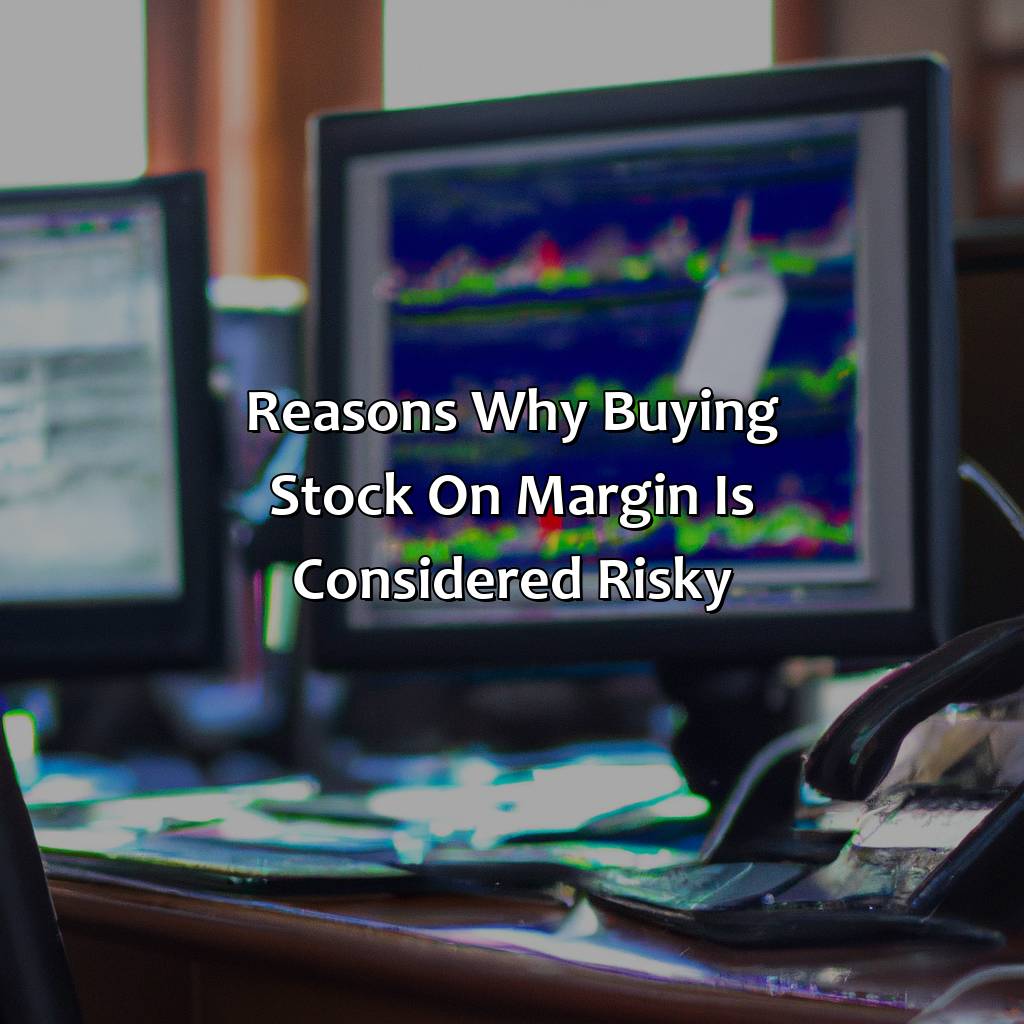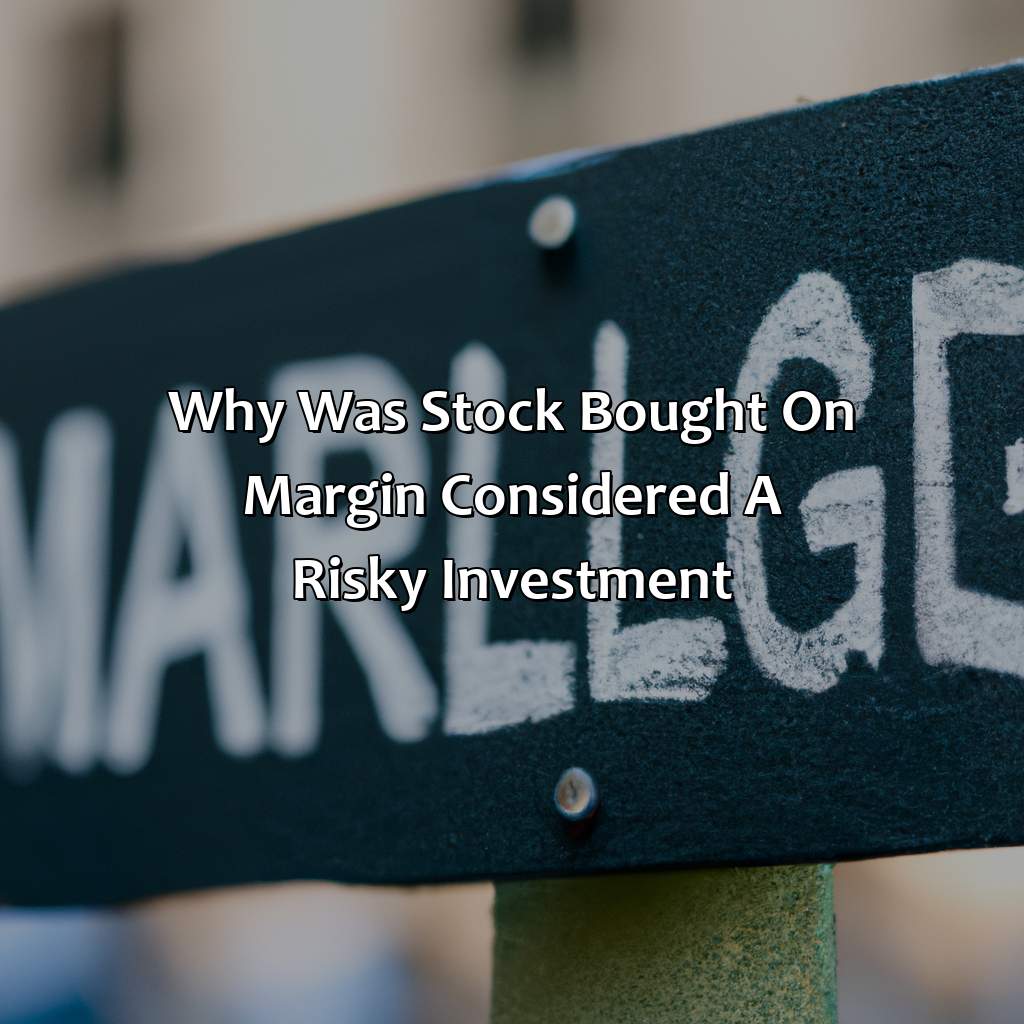Why Was Stock Bought On Margin Considered A Risky Investment?
Key Takeaway:
- Buying stocks on margin is the process of borrowing money from a broker to purchase stocks, and it is considered a risky investment strategy due to the potential for margin calls and forced selling when the value of the stocks decreases.
- Margin calls and forced selling occur when the value of the stocks purchased with margin drops, and the broker demands the investor to increase their margin account to cover the losses. If the investor is unable to do so, the broker can sell the stocks without their consent.
- Buying stocks on margin magnifies losses and increases the level of financial risk for the investor, making it an investment strategy reserved for experienced and financially stable investors.
Are you wondering why stock bought on margin was once considered a risky investment? In this article, we will explore the reasons why, how to mitigate these risks, and what can be done to prevent them. You will understand why margin investing can create financial instability if not managed properly.
Reasons why buying stock on margin is considered risky
Delve into the risks of buying stock on margin. This section introduces two reasons why it is risky: margin calls and forced selling. Plus, there’s the potential for greater losses.

Image credits: retiregenz.com by Yuval Duncun
Margin calls and forced selling
When investment is made on margin, the investor borrows money from a broker to buy stocks. If the value of the stocks fall significantly, the investor may receive a ‘margin call’, where they must deposit additional funds or face forced selling of their stocks to meet a certain level of equity in the account.
This can result in a variety of issues, including loss of control over one’s investments and potential losses higher than one’s initial investment. Forced selling can also lead to significant reductions in stock prices as other investors may try to sell their shares before the price goes further down.
Therefore, buying stocks on margin can be considered a risky investment due to various unforeseen circumstances that can impact an investor’s control over their investments as well as potentially leading to significant losses.
It is crucial for investors to carefully assess their financial situation and risk tolerance before considering such investments. The fear of missing out on potential gains should not overshadow one’s understanding of the risks involved in margin trading.
When it comes to buying stock on margin, a magnifying glass may be handy for spotting potential gains, but a magnifying glass won’t help you see the impending losses.
Magnifying losses
Buying stock on margin can expose investors to the risk of exponentially increasing their losses. By borrowing money from a broker to purchase securities, investors can enhance their potential profit by up to 50% or more. However, this approach significantly magnifies the risk of losses.
When stock prices fall, the investor’s equity decreases rapidly. This leads to a situation where shares held as collateral for margin loans must be sold or additional capital must be added into the account to meet minimum requirements. Additionally, when investors don’t have adequate capital funding and are unable to repay margin loans, brokers can forcefully liquidate part or all of their holdings.
Furthermore, many historical events have shown how buying stocks on margin could result in significant financial loss for investors. One such example was the 1929 stock market crash and subsequent Great Depression, where many traders had overinvested in stocks on margin leading to tremendous financial constraints.
In summary, though buying stocks on margin may provide an opportunity for higher returns, it comes with high risks that could potentially lead to substantial losses. As an informed investor, one should evaluate and carefully consider this option before taking any significant investment action.
Margin call: the two words that strike fear into the heart of any investor, except those who love living on the financial edge.
Historical examples of the dangers of buying stock on margin
To grasp the risks of buying stock on margin, let’s take a look at two historical cases: the Stock Market Crash of 1929 and the Dot-Com Bubble of the late 1990s. Doing so can help us understand the possible consequences of buying on margin. These include high-risk and the potential for massive financial losses.

Image credits: retiregenz.com by James Woodhock
The Stock Market Crash of 1929
The crash of the stock market in 1929 is a historic event that was precipitated by overbuying on margin. This event resulted in significant economic consequences for the US and globally. The overreliance on using margin to invest heavily in stocks led to widespread speculation, which ultimately caused the market’s catastrophic decline.
During this time, buying stock on margin was considered extremely risky, as it involved borrowing money to buy more shares than investors could afford. This contributed to the bubble that eventually burst and sent ripples across the economic landscape.
It is important to note that other factors such as crop failures, policies such as tariffs, and unequal distribution of wealth played a role in this significant economic downturn.
To avoid similar crises recurring today, investors can educate themselves about the risks associated with buying stocks on margin. One suggestion is not to depend solely on leverage for higher returns but rather consider other investment options. Additionally, understanding market trends and diversifying portfolios are crucial steps one must take when investing in stocks.
Turns out the only thing dot-com about the Dot-Com Bubble was the plummeting stock prices.
The Dot-Com Bubble of the late 1990s
During the late 1990s, investing in tech companies was considered a lucrative opportunity due to the rise of the internet. The dot-com bubble saw investors buying companies’ stocks with little regard for their profitability or growth potential, driving up prices to artificially high levels. However, many of these technology companies were unprofitable and eventually failed, leaving investors with substantial losses. This reckless investing on margin caused a catastrophic market crash and led to widespread financial distress.
In addition to this, aggressive marketing tactics by brokerage firms fueled the frenzy even further by encouraging customers to invest more money than they could afford. Many individuals borrowed funds from brokers with interest rates that made it challenging for them to turn a profit.
It’s worth noting that the risks associated with buying stock on margin have been present throughout history. For instance, during the 1920s, many people invested in stocks on credit in hopes of quickly turning a profit during economic recessions which ultimately led to the Great Depression. Moreover, individual investors need to be aware of the dangers of taking out a loan to buy stock on margin without proper knowledge and research.
One such example is that of James Cordier, who lost around $150 million through selling covered options while going against market expectations in 2018. This debacle demonstrated how overconfidence and ignoring warning signs can lead to significant losses when buying stocks on Margin without proper knowledge.
5 Facts About Why Buying Stock on Margin is Considered a Risky Investment:
- ✅ Margin buying involves borrowing money to invest in stocks which magnifies potential gains and losses. (Source: Investopedia)
- ✅ Investors must put up a minimum amount of their own money as collateral and may face margin calls if the value of their investment drops too much. (Source: The Balance)
- ✅ Margin buying is generally only recommended for experienced investors who can afford to take on additional risk. (Source: U.S. Securities and Exchange Commission)
- ✅ Margin buying can increase transaction costs and interest expenses, reducing overall profits. (Source: NerdWallet)
- ✅ The use of margin buying can lead to financial ruin if investors are unable to meet margin calls or if the value of their investments significantly decrease. (Source: The Simple Dollar)
FAQs about Why Was Stock Bought On Margin Considered A Risky Investment?
Why was stock bought on margin considered a risky investment?
Buying stock on margin means borrowing money from a broker to purchase stocks. It was considered a risky investment because the investor not only had to pay back the loan but also had to pay interest on the loan. If the value of the stocks dropped, the investor had to pay the broker the difference in price, and if the investor was not able to pay, the broker would liquidate the stocks.
How did buying stocks on margin contribute to the stock market crash of 1929?
During the 1920s, buying stocks on margin became increasingly popular, and by 1929, investors had borrowed billions of dollars to invest in the stock market. When the stock market crashed, stock prices plummeted, and investors were unable to pay back their loans, leading to the collapse of many banks and financial institutions.
What are the risks of buying stock on margin today?
The risks of buying stock on margin today are similar to those during the 1920s. The investor is taking on debt to invest in the stock market, which can result in significant losses and financial instability if the value of the stock drops. The investor also has to pay interest on the loan and brokerage fees, which can eat into profits.
Is there a safe way to buy stocks on margin?
While there is no completely safe way to buy stocks on margin, some investors use a strategy called a stop-loss order, which automatically sells the stocks if their value drops below a certain price. This can limit losses, but it can also lead to missed opportunities for gains.
What are the alternatives to buying stock on margin?
Alternatives to buying stock on margin include investing in mutual funds, exchange-traded funds, and other low-cost index funds. These investments offer diversification and lower risk than buying individual stocks on margin.
